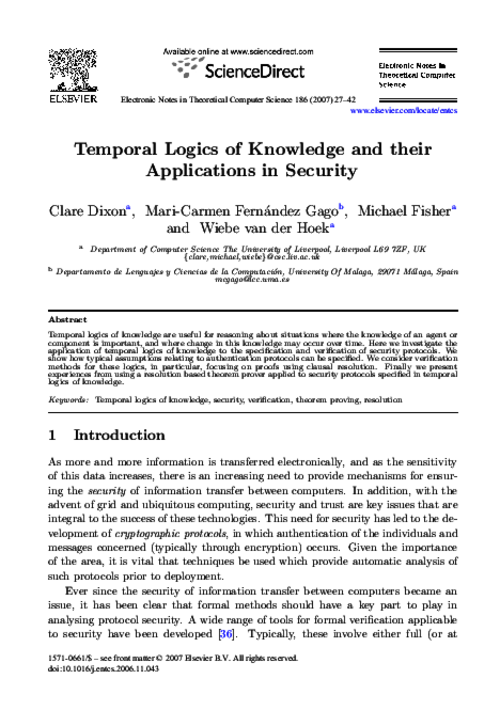 ] Year
] Year Security in Distributed, Grid, Mobile, and Pervasive Computing, Y.. Xiao Eds., Auerbach Publications, pp. 255-288, April, 2007.
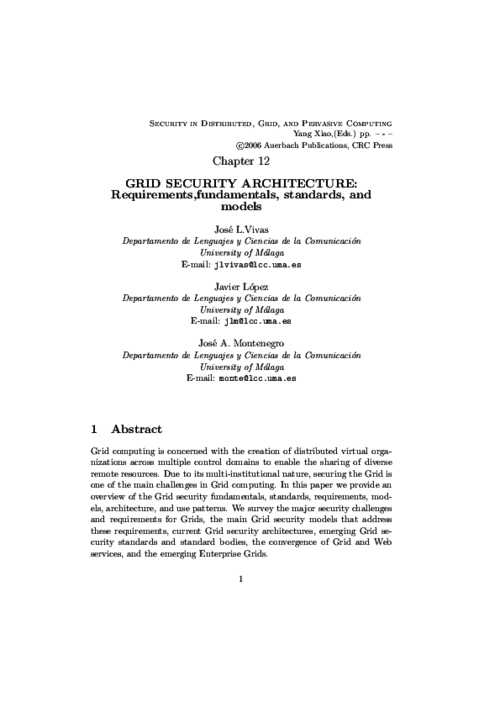
5th Intern. Conf. on Computer Aided Systems Theory and Technology (EUROCAST’97), pp. 183-189, February, 1997.
Abstract
This paper is a first approach to the use of artificial neural networks as a tool to estimate the orientation of an object, and is mainly directed towards industrial applications. The capability of neural networks to generalise is a key element in the calculation of an object’s orientation. In this sense, a neural network can identify the angle of a part never seen before. To evaluate the efficiency of this method we have performed a series of tests with the different parts used in a car assembly line.
IEEE Globecom 2003 - Communications Security Track, IEEE Press, pp. 1506-1510, December, 2003.
Abstract
In order to study the security systems, we have developed a methodology for the application to the analysis of cryptographic protocols of the formal analysis techniques commonly used in communication protocols. In particular, we have extended the design and analysis phases with security properties. Our proposal uses a specification notation based on HMSC/MSC, which can be automatically translated into a generic SDL specification.
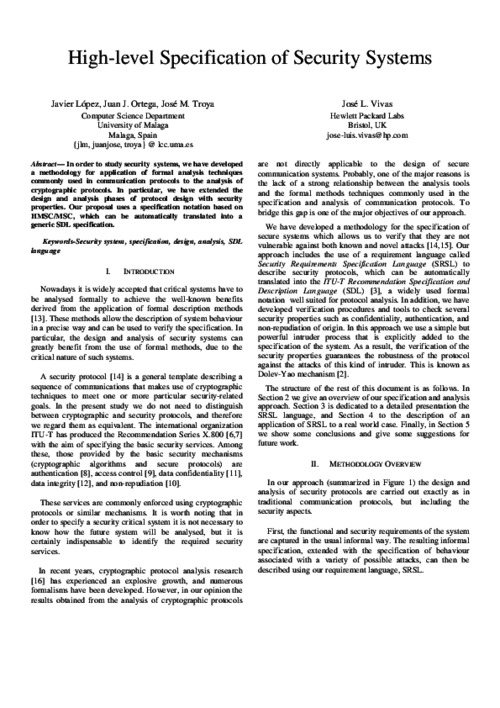
7th IFIP Conference on Multimedia and Communications Security (CMS’03), LNCS 2828, Springer-Verlag, pp. 158-171, October, 2003.
Abstract
Security services are essential for ensuring secure communications. Typically no consideration is given to security requirements during the initial stages of system development. Security is only added latter as an afterthought in function of other factors such as the environment into which the system is to be inserted, legal requirements, and other kinds of constraints. In this work we introduce a methodology for the specification of security requirements intended to assist developers in the design, analysis, and implementation phases of protocol development. The methodology consists of an extension of the ITU-T standard requirements language MSC and HMSC, called SRSL, defined as a high level language for the specification of security protocols. In order to illustrate it and evaluate its power, we apply the new methodology to a real world example, the integration of an electronic notary system into a web-based multi-users service platform.
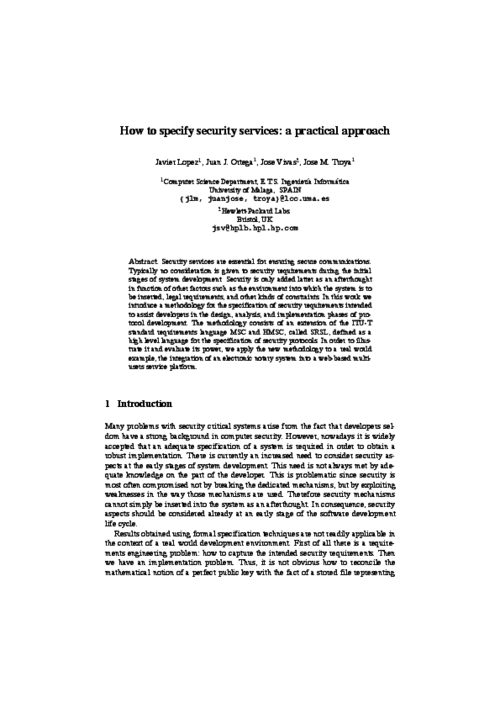
IFIP Conference on Advances in Electronic Government, pp. 109-120, 2000.
XI Jornadas de Ingeniería Telemática (JITEL 2013), J. E. Díaz Verdejo, J. Navarro Ortiz, and J. J. Ramos Muñoz Eds., Asociación de Telemática, pp. 481-486, Oct 2013.
Abstract
La estación base es el elemento más importante en un red de sensores y, por tanto, es necesario evitar que un atacante pueda hacerse con el control de este valioso dispositivo. Para ello, el atacante puede valerse tanto de técnicas de análisis de tráfico como de la captura de nodos. En este trabajo presentamos un esquema que consta de dos fases, la primera está dedicada a homogeneizar los patrones de tráfico y la segunda encargada de perturbar las tablas de rutas de los nodos. Ambas fases permiten mantener a la estación base fuera del alcance del atacante con un coste computacional insignificante y un consumo energético moderado. La validez de nuestro esquema ha sido validada analíticamente y a través de numerosas simulaciones.
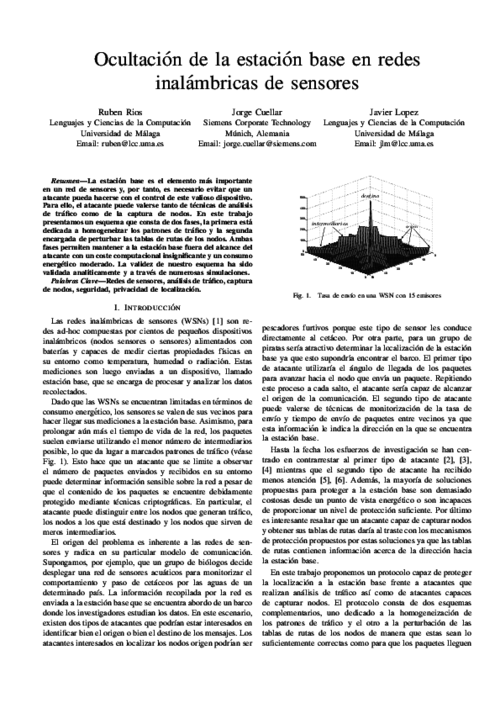
IFIP World Computer Congress, pp. 695-708, August, 1998.
Abstract
The objective of the present work is to present a solution to the problem of simultaneously examining groups of students in different computer laboratories while each student uses a computer with Internet access. The system presented focus on security and ease of use, being, at the same time, transparent to the users (students) and providing added services to the main objective of simultaneous examinations in several rooms with just one teacher.
International Conference on Computer Systems and Technologies (CompSysTech09), ACM, pp. 11.7.1-11.7.6, 2009. DOI
Abstract
Assurance has been a major topic for critical systems. Assurance is usually associated with safety conditions but has also an important role for checking security requirements. Security is best assured if it is addressed holistically, systematically, and from the very beginning in the software’s development process. We propose to integrate assurance and system development by letting the different stages of the system development life-cycle be mapped to the structure of the assurance case.
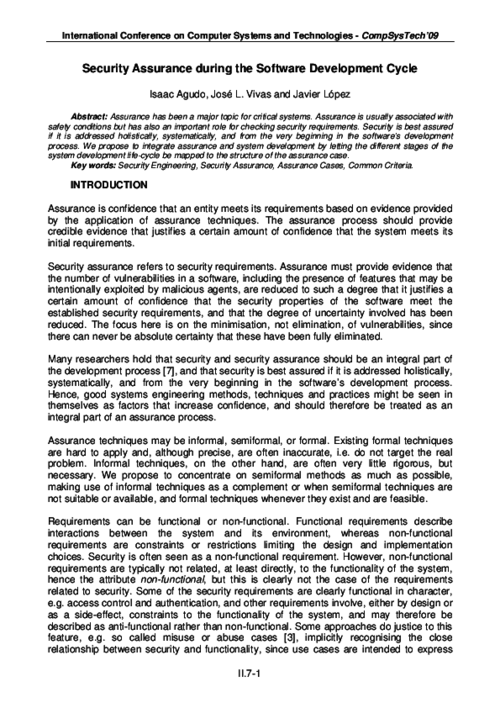
6th International Conference on Information Security (ISC’03), LNCS 2851, Springer-Verlag, pp. 381-395, October, 2003.
Abstract
A challenging task in security engineering concerns the specification and integration of security with other requirements at the top level of requirements engineering. Empirical studies show that it is commonly at the business process level that customers and end users are able to express their security needs. In addition, systems are often developed by automating existing manual business processes. Since many security notions belongs conceptually to the world of business processes, it is natural to try to capture and express them in the context of business models in which moreover customers and end users feel most comfortable. In this paper, based on experience drawn from an ongoing work within the CASENET project \cite{CASENET}, we propose a UML-based business process-driven framework for the development of security-critical systems.
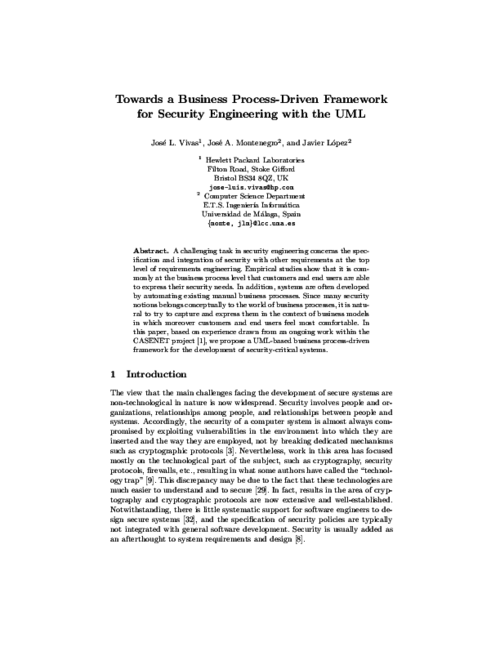
11th International Symposium on Temporal Representation and Reasoning (TIME’04), IEEE Computer Society, pp. 148-151, 2004. DOI
Abstract
Temporal logics of knowledge are useful for reasoning about situations where the knowledge of an agent or component is important, and where change in this knowledge may occur over time. Here we use temporal logics of knowledge to reason about security protocols. We show how to specify part of the Needham-Schroeder protocol using temporal logics of knowledge and prove various properties using a clausal resolution calculus for this logic.
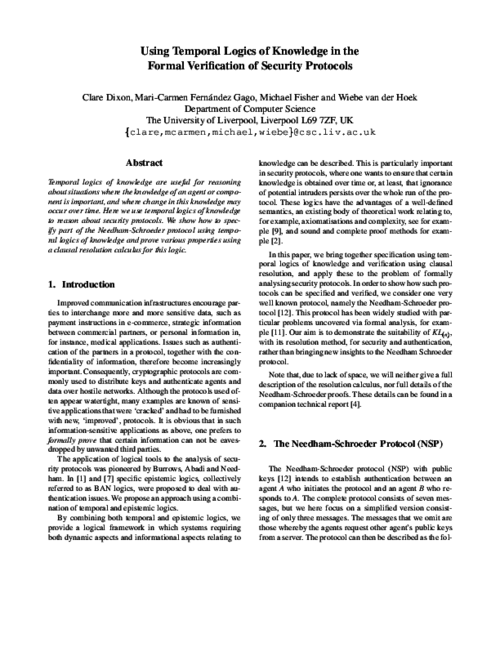
Requirements Engineering, vol. 16, no. 1, Springer, pp. 55-73, Mar 2011. DOI
Abstract
In this work, we introduce an assurance methodology that integrates assurance case creation with system development. It has been developed in order to provide trust and privacy assurance to the evolving European project PICOS (Privacy and Identity Management for Community Services), an international research project focused on mobile communities and community-supporting services, with special emphasis on aspects such as privacy, trust, and identity management. The leading force behind the approach is the ambition to develop a methodology for building and maintaining security cases throughout the system development life cycle in a typical system engineering effort, when much of the information relevant for assurance is produced and feedback can be provided to system developers. The first results of the application of the methodology to the development of the PICOS platform are presented.
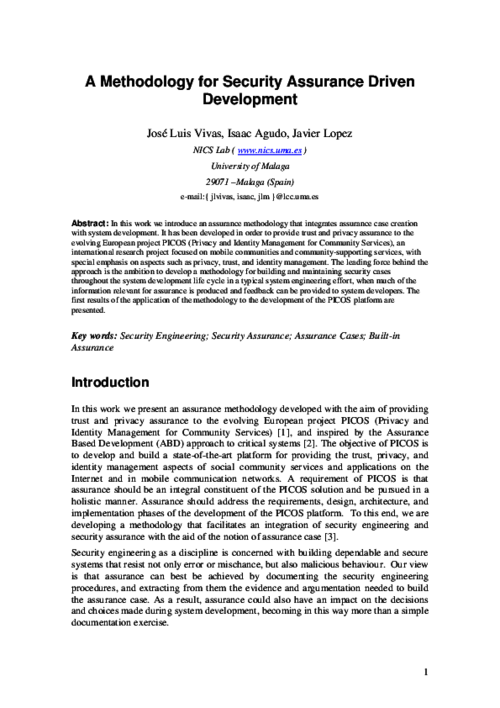
Telecommunication Systems , vol. 59, issue 1, Springer US, pp. 169-187, 05/2015. DOI
Abstract
In this article, we present relay selection policies in applications with secrecy requirements which are of interest in the fifth generation (5G) of wireless networks. More specifically, we provide a classification of relays based on their distinct communication attributes, such as processing, multiple antennas, storage, channel estimation, density and security level. In addition, we discuss the level of efficiency exhibited by each relay class, regarding their impact in delay-critical applications and green communications applications, while aiming at a specific security level at the physical layer. Then, relay selection policies are proposed taking into consideration the goals set by each application. Numerical evaluation of the proposed policies in terms of the average secrecy rate, average delay and power reduction show improved performance compared to other state-of-the-art solutions.
Computer Standards and Interfaces, vol. 32, no. 5-6, Elsevier, pp. 230-245, Oct 2010. DOI
Abstract
This paper describes the security framework that is to be developed for the generic grid platform created for the project GREDIA. This platform is composed of several components that need to be secured. The platform uses the OGSA standards, so that the security framework will follow GSI, the portion of Globus that implements security. Thus, we will show the security features that GSI already provides and we will outline which others need to be created or enhanced.
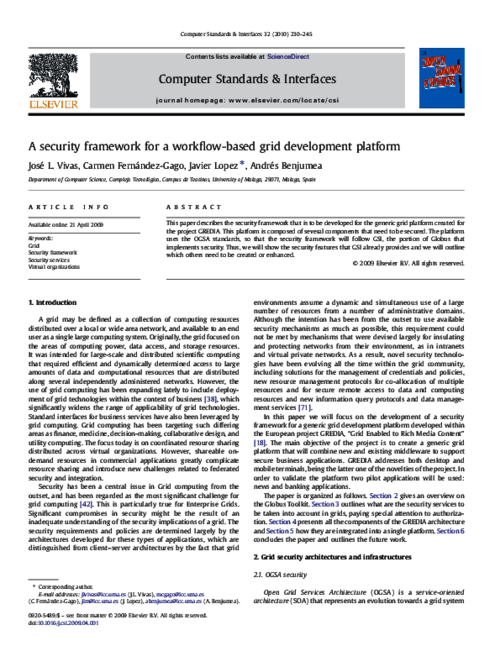
Computer Standards & Interfaces, vol. 27, no. 5, Elsevier, pp. 467-478, Jun 2005. DOI
Abstract
A challenging task in security engineering concerns the specification and integration of security with other requirements at the top level of requirements engineering. Empirical studies show that it is common at the business process level that customers and end users are able to express their security needs. Among the security needs of Internet applications, authentication and authorization services are outstanding and, sometimes, privacy becomes a parallel requirement. In this paper, we introduce a methodology for the specification of security requirements and use a case study to apply our solution. We further detail the resulting system after extending it with an Authentication and Authorization Infrastructure.
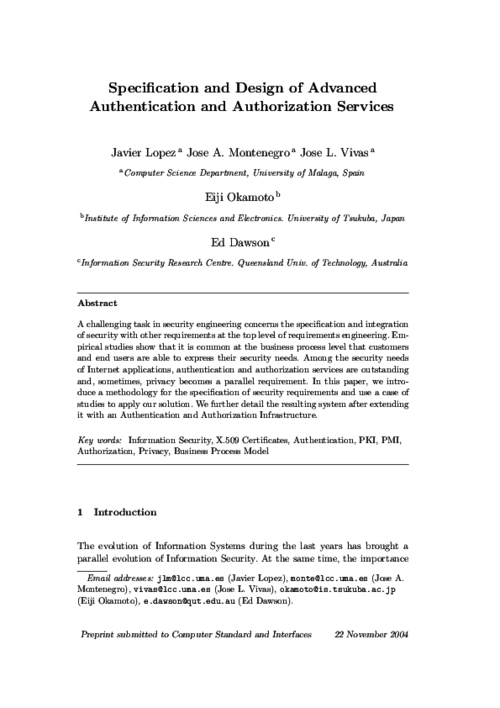
First Workshop in Information and Computer Security (ICS’06), vol. 186, Elsevier, pp. 27-42, 2007. DOI
Abstract
Temporal logics of knowledge are useful for reasoning about situations where the knowledge of an agent or component is important, and where change in this knowledge may occur over time. Here we investigate the application of temporal logics of knowledge to the specification and verification of security protocols. We show how typical assumptions relating to authentication protocols can be specified. We consider verification methods for these logics, in particular, focusing on proofs using clausal resolution. Finally we present experiences from using a resolution based theorem prover applied to security protocols specified in temporal logics of knowledge.
